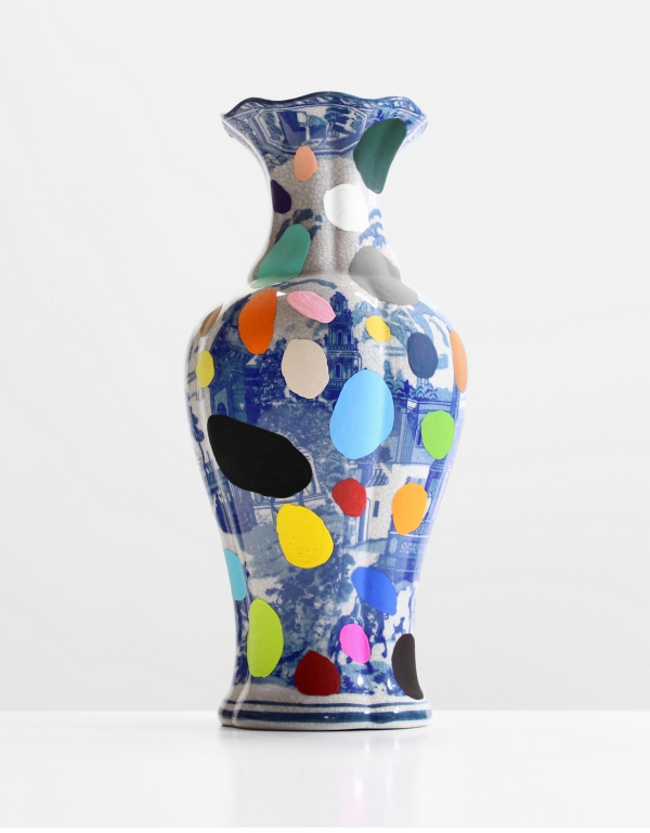CFile’s previous article about Chad Wys elaborated on his use of digital manipulation to deconstruct historical works of art in his project, American Tapestry. The vases here demonstrate that he doesn’t limit his deconstruction, or perhaps even destruction, to digital means. In fact, he doesn’t have many limits at all; he is tremendously prolific in a wide variety of media but what’s more interesting is that he attempts to marry the conceptual ‘deconstructive impulse’ with formal aesthetics. Both threads have clear histories but not many artists admit to giving them equal weight. Wys’ work with found objects intends to examine the notion of objecthood, which carries with it ideas of ownership, history, and aesthetics, at the same time that it is a straightforward exploration of color, composition, and form.
As Wys puts it:
The literal destruction of an object is secondary, in my mind, to the overall effect created by color (dis)harmony and the overall aesthetic-emotional experience of the reclaimed and reinvented object. I openly play with the allure of foreign and aggressive new colors and forms, inviting them into otherwise familiar and traditional settings. Barriers and obstacles are thereby erected between the viewer and the object through which one must negotiate an understanding of what is both present and hidden. What does the creation of new meaning tell us about old meanings, or meaning in general?
The following excerpt of an interview conducted by The Hundred in the Hands (see the link below to read the full article) delves into this dichotomy in Wys’ work.
THITH: There does seem to be a lot of theory suggested by these images of yours but at the same time, they are also just simply pretty to look at. It seems one one level, you’re just playing with color and form in a very formalist manner. Is there a division between these two aspects of your work or in some way are you challenging that too?
CW: There is often an unnecessary division between aestheticism and conceptualism — and much of that division is routed in Art schools today. Studio artists are often taught to be conceptual above all else, and that to merely be an aesthetic artist, interested foremost in beauty, is the kiss of death; on this I don’t completely disagree — but how much weight we should grant concept might be a point on which I diverge in my process. This speaks to the dichotomy that is kitsch versus fine art: or, for example, someone like Thomas Kinkade versus Lucian Freud. Why is one painter “legitimate” in the eyes of art critics, and the other not? What makes “good art”? The ratio of concept to aesthetics factors greatly.
THITH: The danger is to be too overwhelmed by one side?
CW: Relying on beauty and/or sentimentality and, on the opposite end, relying significantly on concept can be equally poor artistic choices. I prefer to indulge in both equally. I revel in a certain amount of guilty pleasure concerning the objects that I unearth at thrift stores and garage sales. A quaint, pastel figurine of two love birds can be, at its most literal core, a beautiful object that mimics great European porcelains that came long before it. But, I am conflicted when I come in contact with kitschy, economical art objects; on the one hand I like indulging in the object’s easy, dumb beauty, but on the other hand my sensibilities as an initiated art enthusiast are insulted by the object’s poor, derivative qualities. I certainly grapple with these conflicts and I play with the idea that beauty can coexist, if not engage in combat, with the intricate critical theories that are given so much weight today.
THITH: These original paintings really suggest a very specific opulence, and you’re displacing and replacing the image with equally elegant and refined contemporary art mannerisms, is there a commentary in this about the roll art plays as a status symbol and luxury good?
CW: The role that art plays as a luxury good is perhaps the constant strand throughout much of my artwork and much of my academic research. I’m very interested in this and most of my writing is squarely fixed on the problem of art as a commodity. That is to say: how does art function in culture as both a deeply poetic utterance to be thoughtfully considered, and also as a commodity to be traded and displayed for decorative and luxurious reasons? Similar concerns are also pointed at by much of my artwork. I enter thrift stores and fixate on economical pieces that have lived an easy life on the shelves or above the fireplaces of their middle-class owners; many of the objects I find mimic finer pieces held within the world’s grandest museums — objects that neither the middle-class owner, nor I, could ever hope to afford. We decorate our lives with objects that make us feel more complete or more elevated intellectually and/or financially… when it’s all very much an illusion.
Above image: Chad Wys, Delft Punk, 2013. Paint on found ceramic. 14″ x 7.5″ (diameter). Photograph courtesy of the artist.


Chad Wys, Sprayed Chinese Vase, 2009. Spray paint on found ceramic.12″ x 6″ (diameter).

Chad Wys, Deleted Chinese Vase, 2011. Paint on found ceramic.12″ x 4.5″ (diameter).

Chad Wys, Flower Vase, 2011. Mixed media on found ceramic. 10″ x 5″ (diameter). All images courtesy of the artist.
Read more of The Hundred in the Hands’ interview with Chad Wys
Read CFile’s previous post on Chad Wys’ American Tapestry

I love the vases !
Where can I see those ? Can I buy a vase ?
kind regards,
Isabelle Santens